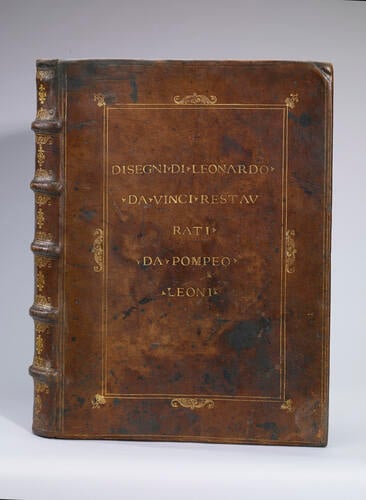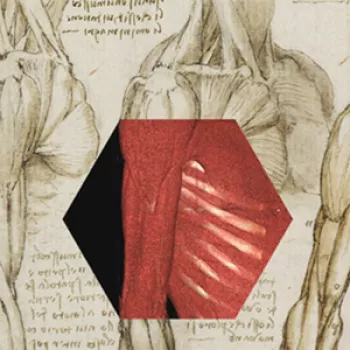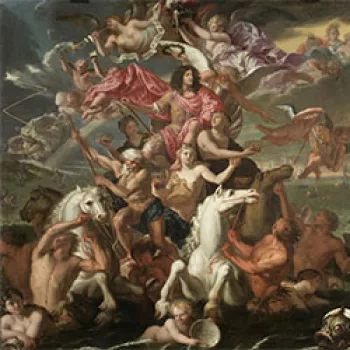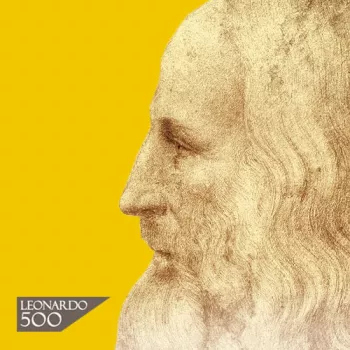The Leoni binding c. 1590
Leather, gold tooling | 47.0 x 33.0 x 6.5 cm (album) | RCIN 933320
-
This is the leather binding of the album made up for Pompeo Leoni in the late sixteenth century to house over 500 of Leonardo’s drawings, including all the anatomical studies now known. The album was brought to England, probably by the agents of Thomas Howard, 2nd Earl of Arundel, around 1620. By 1690 the album was in the Royal Collection, probably having been acquired by Charles II some years earlier. Leonardo’s drawings (RCIN 912275-912726, 919000-919154 etc) were removed from the album, to protect and display them, during the nineteenth century.
On Leonardo’s death in France on 2 May 1519, he bequeathed to his pupil Francesco Melzi ‘each and every one of his books’ and ‘other tools and depictions [Instrumenti et Portracti] pertaining to his art and craft of painting’, presumably including his drawings. Melzi took this mass of material back to his family residence at Vaprio outside Milan, and over the next 50 years attempted to put Leonardo’s papers into order, arranging the loose sheets broadly by subject matter in at least five sequences which he annotated with consecutive numbers, seen on most of the drawings here.
After Melzi’s death around 1570, the sculptor Pompeo Leoni acquired the bulk of the loose sheets from Melzi’s son, and mounted them on the pages of (at least) two albums: technical studies in the large Codex Atlanticus, now in the Biblioteca Ambrosiana in Milan, and more artistic drawings in a smaller album, containing around 600 sheets mounted on 234 folios. That album was listed in an inventory of Leoni’s residence after his death in Madrid in 1608, and by 1630 it was in England, in the collection of Thomas Howard, 14th Earl of Arundel, then the greatest collector of drawings in Europe. The album may have been a direct purchase by one of Arundel’s agents; alternatively, it may have been acquired by the Prince of Wales (later Charles I) during his visit to Madrid in 1623, or by his companion on that trip, the Duke of Buckingham, and acquired by Arundel soon after.
On the outbreak of the Civil War in 1642, Arundel left England for Antwerp, taking some, but not all, of his collection with him. Henry Howard, grandson of the Earl and later 6th Duke of Norfolk, was noted as being in possession of part of Arundel’s collection in 1655, and in 1663/4 he was displaying to Christmas guests at the family palace in Norwich ‘prints and draughts done by most of the Great Masters own hands … most of them collected by the old Earl of Arundel who employed his agents in most places to buy him up rarities’. By 1690 the Leonardo album was in royal ownership, for Constantijn Huygens, secretary to William III, noted in his diary that at Whitehall Palace ‘we looked through four or five books of drawings, including some by Holbein and Leonardo da Vinci’. It is probable that the album had passed to the royal collection some years earlier – most likely Henry Howard gave it (and another of drawings by Hans Holbein) to Charles II, perhaps in thanks for the restitution of the Norfolk lands and titles after the Restoration of the monarchy in 1660.
Over the next century and a half the album received little attention, moving between various royal residences until it finally settled in the new Royal Library at Windsor Castle in the 1830s. During the reign of Queen Victoria the drawings were removed from the albums and mounted individually, allowing them to be exhibited; by the early twentieth century all the Leonardos had been mounted, and many were then stamped in the lower right corner with the cipher of Edward VII. Whereas most bindings were discarded during this process, the Leoni binding was fortunately preserved as a relic of the master, the repository for three centuries of much of what we know about Leonardo.
Text adapted from Leonardo da Vinci: A life in drawing, London, 2018Provenance
Pompeo Leoni, c.1582-90; Thomas Howard, 14th Earl of Arundel, by 1630; probably acquired by Charles II; Royal Collection by 1690
-
Creator(s)
Acquirer(s)
-
Medium and techniques
Leather, gold tooling
Measurements
47.0 x 33.0 x 6.5 cm (album)
Object type(s)
Other number(s)
RL 33320











